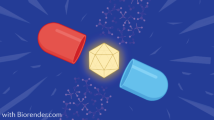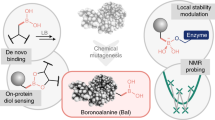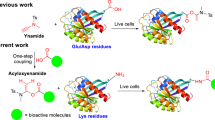Abstract
Boron-containing molecules have been extensively used for the purposes of chemical sensing, biological probe development and drug discovery. Due to boron's empty p orbital, it can coordinate to heteroatoms such as oxygen and nitrogen. This reversible covalent mode of interaction has led to the use of boron as bait for nucleophilic residues in disease-associated proteins, culminating in the approval of new therapeutics that work by covalent mechanisms. Our analysis of a wide range of covalent inhibitors with electrophilic groups suggests that boron is a unique electrophile in its chameleonic ability to engage protein targets. Here we review boron's interactions with a range of protein side-chain residues and reveal that boron's properties are nuanced and arise from its uncommon coordination preferences. These mechanistic and structural insights should serve as a guide for the development of selective boron-based bioactive molecules.
This is a preview of subscription content, access via your institution
Access options
Access Nature and 54 other Nature Portfolio journals
Get Nature+, our best-value online-access subscription
$29.99 / 30 days
cancel any time
Subscribe to this journal
Receive 12 print issues and online access
$259.00 per year
only $21.58 per issue
Buy this article
- Purchase on Springer Link
- Instant access to full article PDF
Prices may be subject to local taxes which are calculated during checkout









Similar content being viewed by others
References
Protein Data Bank (Research Collaboratory for Structural Bioinformatics, 2017); http://go.nature.com/2tkYmNB
Murphy, B. P. & Pratt, R. F. Evidence for an oxyanion hole in serine β-lactamases and DD-peptidases. Biochem. J. 256, 669–672 (1988).
Usher, K. C., Blaszczak, L. C., Weston, G. S., Shoichet, B. K. & Remington, S. J. Three-dimensional structure of AmpC β-lactamase from Escherichia coli bound to a transition-state analogue: possible implications for the oxyanion hypothesis and for inhibitor design. Biochemistry 37, 16082–16092 (1998).
Koehler, K. A. & Lienhard, G. E. 2-Phenylethaneboronic acid, a possible transition-state analog for chymotrypsin. Biochemistry 10, 2477–2483 (1971).
Matthews, D. A., Alden, R. A., Birktoft, J. J., Freer, S. T. & Kraut, J. X-ray crystallographic study of boronic acid adducts with substilisin BPN′ (Novo). A model for the catalytic transition state. J. Biol. Chem. 250, 7120–7126 (1975).
Kettner, C. A. & Shenvi, A. B. Inhibition of serine proteases leukocyte elastase, pancreatic elastase, cathespsin G, and chymotrypsin by peptide boronic acids. J. Biol. Chem. 259, 15106–15114 (1984).
Farr-Jones, S., Smith, S. O., Kettner, C. A., Griffin, R. G. & Bachovchin, W. W. Crystal versus solution structure of enzymes: NMR spectroscopy of a peptide boronic acid-serine protease complex in crystalline state. Proc. Natl Acad. Sci. USA 86, 6922–6924 (1989).
Katz, B. A., Finer-Moore, J., Mortezaei, R., Rich, D. H. & Stroud, R. M. Episelection: novel Ki ∼ nanomolar inhibitors of serine proteases selected by binding or chemistry on an enzyme surface. Biochemistry 34, 8264–8280 (1995).
Behnam, M. A. M., Sundermann, T. R. & Klein, C. D. Solid phase synthesis of C-terminal boronic acid peptides. Org. Lett. 18, 2016–2019 (2016).
Fuhrmann, C. N., Daugherty, M. D. & Agard, D. A. Subangstrom crystallography reveals that short ionic hydrogen bonds, and not a His-Asp low-barrier hydrogen bond, stabilize the transition state in serine protease catalysis. J. Am. Chem. Soc. 128, 9086–9102 (2006).
Rosholm, T., Gois, P. M. P., Franzen, R. & Candeias, N. R. Glycerol as an efficient medium for the Petasis borono–Mannich Reaction. ChemistryOpen 4, 39–46 (2015).
Nitsche, C. et al. Peptide-boronic acid inhibitors of flaviviral proteases: medicinal chemistry and structural biology. J. Med. Chem. 60, 511–516 (2017).
Lei, J. et al. Crystal structure of Zika virus NS2B-NS3 protease in complex with a boronate inhibitor. Science 353, 503–505 (2016).
Shirley, M. Ixazomib: first global approval. Drugs 76, 405–411 (2016).
Kupperman, E. et al. Evaluation of the proteasome inhibitor MLN9708 in preclinical models of human cancer. Cancer Research 70, 1970–1980 (2010).
Schrader, J. et al. The inhibition mechanism of human 20S proteasomes enables next-generation inhibitor design. Science 353, 595–598 (2016).
Morandi, F. et al. Nanomolar inhibitors of AmpC β-lactamase. J. Am. Chem. Soc. 125, 685–695 (2003).
Gonzalez, J. A. et al. MIDA boronates are hydrolysed fast and slow by two different mechanisms. Nat. Chemistry 8, 1067–1075 (2016).
Diaz, D. B. et al. Synthesis of aminoboronic acid derivatives from amines and amphoteric boryl carbonyl compounds. Angew. Chem. Int. Ed. 55, 12659–12663 (2016).
Adachi, S. et al. Facile synthesis of borofragments and their evaluation in activity-based protein profiling. Chem. Commun. 51, 3608–3611 (2015).
Llona-Minguez, S. et al. Discovery of the first potent and selective inhibitors of human dCTP pyrophosphatase 1. J. Med. Chem. 59, 1140–1148 (2016).
Zajdlik, A. et al. α-Boryl isocyanides enable facile preparation of bioactive boropeptides. Angew. Chem. Int. Ed. 52, 8411–8415 (2013).
Hecker, S. J. et al. Discovery of a cyclic boronic acid β-lactamase inhibitor (RPX7009) with utility vs class A serine carbapenemases. J. Med. Chem. 58, 3682–3692 (2015).
Tondi, D. et al. Targeting Class A and C serine β-lactamases with a broad-spectrum boronic acid derivative. J. Med. Chem. 57, 5449–5458 (2014).
Li, X. et al. Novel macrocyclic HCV NS3 protease inhibitors derived from α-amino cyclic boronates. Bioorg. Med. Chem. Lett. 20, 5695–5700 (2010).
Lai, J. H. et al. Synthesis and characterization of constrained peptidomimetic dipeptidyl peptidase IV inhibitors: amino-lactam boroalanines. J. Med. Chem. 50, 2391–2398 (2007).
Coutts, S. J. et al. Structure-activity relationships of boronic acid inhibitors of dipeptidyl peptidase IV. 1. Variation of the P2 position of Xaa-boroPro dipeptides. J. Med. Chem. 39, 2087–2094 (1996).
Snow, R. J. et al. Studies on proline boronic acid dipeptide inhibitors of dipeptidyl peptidase IV: identification of a cyclic species containing a B–N bond. J. Am. Chem. Soc. 116, 10860–10869 (1994).
Engel, M. et al. Rigidity and flexibility of dipeptidyl peptidase IV: crystal structures of and docking experiments with DPIV. J. Mol. Biol. 355, 768–783 (2006).
Martichonok, V. & Jones, J. B. Probing the specificity of the serine proteases subtilisin carlsberg and α-chymotrypsin with enantiomeric 1-acetamido boronic acids. An unexpected reversal of the normal “L”-stereoselectivity preference. J. Am. Chem. Soc. 118, 950–958 (1996).
Stoll, V. S. et al. Differences in binding modes of enantiomers of 1-acetamido boronic acid based protease inhibitors: crystal structures of γ-chymotrypsin and subtilisin Carlsberg complexes. Biochemistry 37, 451–462 (1998).
Chen, Z. J. et al. The N–B interaction through a water bridge: understanding the chemoselectivity of a fluorescent protein based probe for peroxynitrite. J. Am. Chem. Soc. 138, 4900–4907 (2016).
Zervosen, A. et al. Unexpected tricovalent binding mode of boronic acids within the active site of a penicillin-binding protein. J. Am. Chem. Soc. 133, 10839–10848 (2011).
Adams, J. et al. Potent and selective inhibitors of the proteasome: dipeptidyl boronic acids. Bioorg. Med. Chem. Lett. 8, 333–338 (1998).
LeBeau, A. M., Singh, P., Isaacs, J. T. & Denmeade, S. R. Potent and selective peptidyl boronic acid inhibitors of the serine protease prostate-specific antigen. Chemistry and Biology 15, 665–674 (2008).
Martinchonok, V. & Jones, B. Cysteine proteases such as papain are not inhibited by substrate analogue peptidyl boronic acids. Bioorg. Med. Chem. Lett. 5, 679–684 (1997).
Gutierrez-Moreno, N. J., Medrano, F. & Yatsimirsky, A. K. Schiff base formation and recognition of amino sugars, aminoglycosides and biological polyamines by 2-formyl phenylboronic acid in aqueous solution. Org. Biomol. Chem. 10, 6960–6972 (2012).
Bandyopadhyay, A., McCarthy, K. A., Kelly, M. A. & Gao, J. Targeting bacteria via iminoboronate chemistry of amine-presenting lipids. Nat. Commun. 6, 6561 (2015).
Cal, P. M. S. D. et al. Iminoboronates: a new strategy for reversible protein modification. J. Am. Chem. Soc. 134, 10299–10305 (2012).
Akçay, G. et al. Inhibition of Mcl-1 through covalent modification of a noncatalytic lysine side chain. Nat. Chem. Biol. 12, 931–936 (2016).
Sgrignani, J., Beatrice, N., Colombo, G. & Grazioso, G. Covalent docking of selected boron-based serine beta-lactamase inhibitors. J. Comput. Aided Mol. Des. 29, 441–450 (2015).
London, N. et al. Covalent docking of large libraries for the discovery of chemical probes. Nat. Chem. Biol. 10, 1066–1075 (2014).
Malhotra, S. & Karanicolas, J. When does chemical elaboration induce a ligand to change its binding mode? J. Med. Chem. 60, 128–145 (2017).
Bone, R., Frank, D., Kettner, C. A. & Agard, D. A. Structural analysis of specificity: α-lytic protease complexes with analogues of reaction intermediates. Biochemistry 28, 7600–7609 (1989).
Clevenger, K. D., Wu, R., Liu, D. & Fast, W. n-Alkylboronic acid inhibitors reveal determinants of ligand specificity in the quorum-quenching and siderophore biosynthetic enzyme PvdQ. Biochemistry 53, 6679–6686 (2014).
Clevenger, K. D., Wu, R., Er, J. A., Liu, D. & Fast, W. Rational design of a transition state analogue with picomolar affinity to Pseudomonas aeruginosa PvdQ, a siderophore biosynthetic enzyme. ACS Chem. Biol. 8, 2192–2200 (2013).
Amani, J. & Molander, G. A. Toward efficient nucleophilic azaborine building blocks for the synthesis of B–N naphthyl (hetero)arylmethane isosteres. Org. Lett. 17, 3624–3627 (2015).
Adachi, S. et al. Condensation-driven assembly of boron-containing bis(heteroaryl) motifs using a linchpin approach. Org. Lett. 17, 5594–5597 (2015).
Zhao, P., Nettletone, D. O., Karki, R. G., Zécri, F. J. & Liu, S.-Y. Medicinal chemistry profiling of monocyclic 1, 2-azaborines. Chem. Med. Chem. 12, 358–361 (2017).
Zhou, H.-B. et al. Elemental isomerism: a boron–nitrogen surrogate for a carbon–carbon double bond increases the chemical diversity of estrogen receptor ligands. Chemistry and Biology 14, 659–669 (2007).
Chrostowska, A. et al. UV-Photoelectron spectroscopy of 1,2- and 1,3-Azaborines: a combined experimental and computational electronic structure analysis. J. Am. Chem. Soc. 134, 10279–10285 (2012).
Baggett, A. W., Vasiliu, M., Li, B., Dixon, D. A. & Liu, S.-Y. Late-stage functionalization of 1,2-dihydro-1,2-azaborines via regioselective iridium-catalyzed C–H borylation: the development of a new N, N-bidentate ligand scaffold. J. Am. Chem. Soc. 137, 5536–5541 (2015).
Lee, H., Fischer, M., Shoichet, B. K. & Liu, S.-Y. Hydrogen bonding of 1,2-azaborines in the binding cavity of T4 lysozyme mutants: structures and thermodynamics. J. Am. Chem. Soc. 138, 12021–12024 (2016).
Liu, L., Marwitz, A. J. V., Matthews, B. W. & Liu, S.-Y. Boron mimetics: 1,2-dihydro-1,2-azaborines bind inside a nonpolar cavity of T4 lysozyme. Angew. Chem. Int. Ed. 48, 6817–6819 (2009).
Morton, A., Baase, W. A. & Matthews, B. W. Biochemistry 34, 8564–8575 (1995).
Tomsho, J. W., Pal, A., Hall, D. G. & Benkovic, S. J. Ring structure and aromatic substituent effects on the pKa of the benzoxaborole pharmacophore. ACS Med. Chem. Lett. 3, 48–52 (2012).
Dowlut, M. & Hall, D. G. An improved class of sugar-binding boronic acids, soluble and capable of complexing glycosides in neutral water. J. Am. Chem. Soc. 128, 4226–4227 (2006).
Torssell, K. Zur kenntnis der arylborsauren 0.3. Bromierung der tolylborsauren nach wohl-ziegler [in German]. Ark. Kemi. 10, 507–511 (1957).
Rock, F. L. et al. An antifungal agent inhibits an aminoacyl-tRNA synthetase by trapping tRNA in the editing site. Science 316 1759–1761 (2007).
Hernandez, V. et al. Discovery of a novel class of boron-based antibacterials with activity against gram-negative bacteria. Antimicrobial Agents and Chemotherapy 57, 1394–1403 (2013).
Alterio, V. et al. Benzoxaborole as a new chemotype for carbonic anhydrase inhibition. Chem. Commun. 52, 11983–11986 (2016).
Akama, T. et al. Linking phenotype to kinase: identification of a novel benzoxaborole hinge-binding motif for kinase inhibition and development of high-potency rho kinase inhibitors. J. Pharmacol. Exp. Ther. 347, 615–625 (2013).
D'Antonio, E. L. & Christianson, D. W. Crystal structures of complexes with cobalt-reconstituted human arginase I. Biochemistry 50, 8018–8027 (2011).
Cama, E. et al. Inhibitor coordination interactions in the binuclear manganese cluster of arginase. Biochemistry 43, 8987–8999 (2004).
Van Zandt, M. C. et al. Discovery of (R)-2-amino-6-boron-2-(2-(piperidin-1-yl)ethyl)hexanoic acid congeners as highly potent inhibitors of human arginases I and II for treatment of myocardial reperfusion injury. J. Med. Chem. 56, 2568–2580 (2013).
Golebiowski, A. et al. Synthesis of quaternary α-amino acid-based arginase inhibitors via the Ugi reaction. Bioorg. Med. Chem. Lett. 23, 4837–4841 (2013).
Fruend, Y. R. et al. Boron-based phosphodiesterase inhibitors show novel binding of boron to PDE4 bimetal center. FEBS Letters 586, 3410–3414 (2012).
D'Antonio, E. L., Y., H. & Christianson, D. W. Structure and function of non-native metal clusters in human arginase I. Biochemistry 51, 8399–8409 (2012).
Brem, J. et al. Structural basis of metallo-β-lactamase, serine-β-lactamase and penicillin-binding protein inhibition by cyclic boronates. Nature Communications 7, 12406 (2016).
Albers, H. M. H. G. et al. Structure-based design of novel boronic acid-base inhibitors of autotaxin. J. Med. Chem. 54, 4619–4626 (2011).
Hausmann, J. et al. Structural basis of substrate discrimination and integrin binding by autotaxin. Nat. Struct. Mol. Bio. 18, 198–204 (2011).
Martinez, S., Wu, R., Sanishvili, R., Liu D. & Holz, R. The active site sulfenic acid ligand in nitrile hydratases can function as a nucleophile. J. Am. Chem. Soc. 136, 1186–1189 (2014).
Acknowledgements
We would like to thank the Natural Science and Engineering Research Council (NSERC) and the Canadian Institutes of Health Research (CIHR) for financial support. Helpful discussions with Harjeet Soor (UofT) and Frank Lee (UofT) are gratefully appreciated. D.B.D. also thanks NSERC for PGS-D funding.
Author information
Authors and Affiliations
Corresponding author
Ethics declarations
Competing interests
The authors declare no competing financial interests.
Rights and permissions
About this article
Cite this article
Diaz, D., Yudin, A. The versatility of boron in biological target engagement. Nature Chem 9, 731–742 (2017). https://doi.org/10.1038/nchem.2814
Received:
Accepted:
Published:
Issue Date:
DOI: https://doi.org/10.1038/nchem.2814
This article is cited by
-
A small molecule inhibitor prevents gut bacterial genotoxin production
Nature Chemical Biology (2023)
-
A practical preparation of bicyclic boronates via metal-free heteroatom-directed alkenyl sp2-C‒H borylation
Communications Chemistry (2023)
-
Photoelectrochemical oxidative C(sp3)−H borylation of unactivated hydrocarbons
Nature Communications (2023)
-
Covalent-reversible peptide-based protease inhibitors. Design, synthesis, and clinical success stories
Amino Acids (2023)
-
Boron-Containing Compounds for Prevention, Diagnosis, and Treatment of Human Metabolic Disorders
Biological Trace Element Research (2023)



